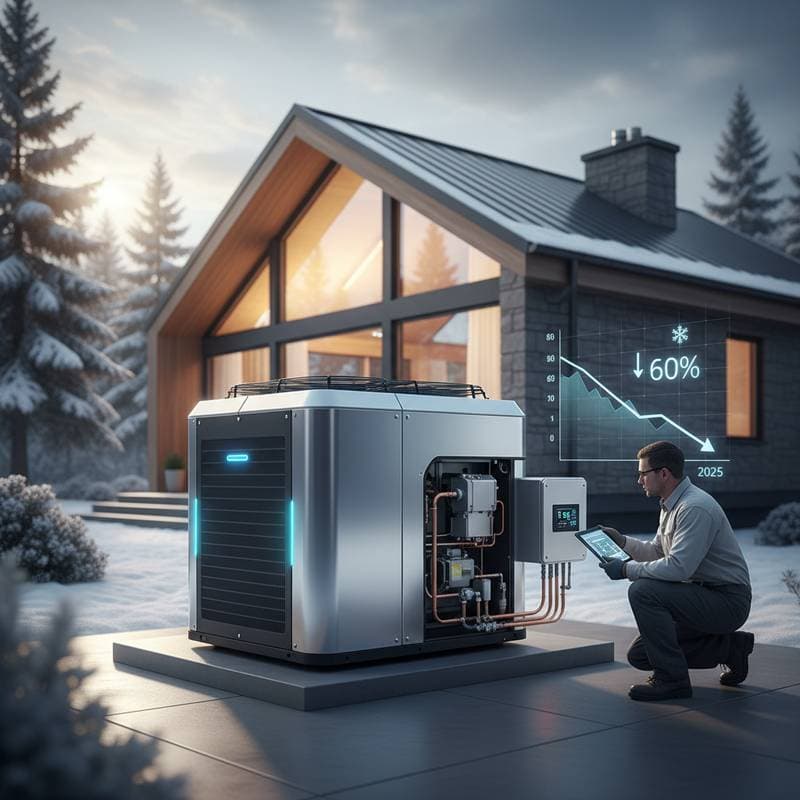Variable Speed Compressors: Slash Summer Bills by 60%
As an HVAC professional, I have observed numerous homeowners facing escalating summer energy expenses while their air conditioners operate continuously to combat rising temperatures. Imagine your unit activating at maximum power to rapidly lower the indoor temperature, then deactivating, only to restart shortly thereafter. This repetitive cycling consumes excessive energy, accelerates component degradation, and results in inconsistent comfort levels. Variable speed compressor technology offers a more efficient and seamless solution for maintaining a cool environment.
Challenges Faced by Traditional AC Systems During Peak Heat
Conventional air conditioning units rely on single-speed compressors that function either at full capacity or remain idle. In intense summer conditions, these systems engage in frequent on-off cycles, drawing substantial electricity. Such operation resembles navigating stop-and-go traffic in a vehicle: it achieves the destination, yet expends considerably more fuel than maintaining a consistent speed.
Based on extensive field experience, homeowners incur cooling costs up to 60 percent higher due to this inefficiency. Although the system cools the space, it labors unnecessarily, elevating expenses and reducing equipment durability.
The Advantages of Variable Speed Compressors
Variable speed compressors, commonly referred to as inverter-driven units, dynamically adjust their performance to align with precise cooling demands. Rather than operating solely at maximum output, they vary speeds from low to high based on indoor and outdoor conditions. This flexibility sustains uniform temperatures with significantly reduced energy consumption.
During periods of minimal cooling requirement, the compressor operates at a reduced speed, minimizing electricity usage. As midday heat intensifies, it increases output sufficiently to preserve comfort without excess. Consequently, cooling remains quiet and steady, free from the abrupt temperature fluctuations typical of legacy systems.
Immediate Benefits from Expert Installation
-
Substantial Energy Reduction: Transitioning to variable speed technology frequently yields up to 60 percent lower energy consumption. The design eliminates the power-intensive startup surges associated with traditional cycling, conserving electricity through gradual adjustments.
-
Superior Temperature Stability: These units hold indoor temperatures within one-half degree of the thermostat setting. Hot spots and sudden chills become relics of the past.
-
Extended System Durability: Operating below full capacity most of the time reduces stress on components, potentially prolonging the unit's service life by multiple years.
-
Reduced Noise Levels: Fewer activations and deactivations result in markedly quieter performance. Many users report the operation as nearly imperceptible.
-
Better Humidity Management: Prolonged low-speed cycles enhance dehumidification, creating a fresher indoor atmosphere that permits higher thermostat settings without discomfort.
Essential Factors for Optimal Performance
Superior variable speed technology demands accurate sizing and installation to realize its potential. I advise conducting a detailed Manual J load calculation to assess your home's specific cooling needs. This process prevents inefficiencies such as short cycling or inadequate temperature control.
An improperly sized unit leads to continuous operation or rapid cycling, both of which compromise energy savings and comfort. Proper configuration, encompassing sealed ducts and calibrated thermostats, enables the compressor to operate at peak efficiency.
Practical Strategies to Enhance System Efficiency
-
Arrange Annual Professional Servicing: Routine inspections maintain optimal refrigerant charges, clean coils, and balanced airflow, safeguarding long-term performance.
-
Install a Programmable Thermostat: Advanced models analyze usage patterns to fine-tune compressor speeds, further optimizing energy use.
-
Address Insulation and Air Leakage: Sealing gaps and improving attic insulation prevents conditioned air loss, allowing the system to function more effectively.
-
Inspect and Replace Air Filters Regularly: Monthly checks ensure unrestricted airflow, preventing the compressor from overworking and eroding savings.
Evaluating Costs and Return on Investment
Initial expenses for variable speed systems exceed those of single-speed alternatives, typically falling between $5,000 and $9,000 based on capacity and manufacturer. However, reduced operational costs often achieve up to 60 percent energy savings, recouping the premium over time.
Eligibility for utility rebates enhances affordability. Paired with expert installation and thermostat upgrades, the return period shortens considerably. Beyond financial gains, the elevated comfort justifies the upgrade for discerning homeowners.
Ensuring Safety and Regulatory Adherence
These compressors incorporate sophisticated electronics and refrigerant management systems that necessitate expert handling. Improper management of refrigerants or electrical elements poses risks. Engage licensed HVAC technicians for all installations and maintenance to comply with safety standards and preserve warranty validity.
Anticipated Outcomes in Everyday Use
In high-humidity areas, users experience diminished moisture and stable temperatures. In arid environments, consistent operation avoids unnecessary overcooling. As my colleague, technician Miguel R., notes, "Replacing a single-speed unit with an inverter model delivers noticeable improvements almost instantly. The airflow feels more even, and bills decrease right away."
Steps to Upgrade Your Cooling System
Upgrading to a variable speed compressor provides reliable comfort and meaningful savings. Contact a certified HVAC specialist through our service for a complimentary assessment. They will review your existing equipment, determine ideal sizing, and oversee code-compliant installation. This approach elevates your home's cooling while controlling energy expenditures.
FAQs
Q: Is it possible to retrofit a variable speed compressor into an existing AC unit?
A: Generally, this is not feasible. Compatibility requires integrated inverter controls and components, making a complete system replacement the preferred option for reliable results.



